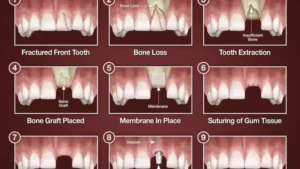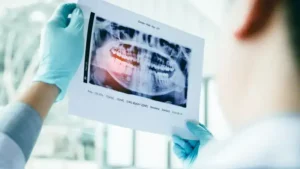Dental bone grafting is a common procedure that helps to restore lost bone in the jaw. It is often necessary before getting dental implants. The process involves taking bone from another part of the body or using synthetic bone materials. The graft serves as a foundation for dental implants, helping to restore proper functionality and aesthetics. However, like any surgery, it comes with risks. One of these risks is the Failed Dental Bone Graft Healing Pictures, which can significantly affect the healing process.
Visit WORLD JOURNEY MAGAZINE for more details
What Is a Bone Graft and Why It’s Needed?
Bone grafting in dentistry is necessary when a patient has insufficient bone for a dental implant. The bone may have deteriorated due to infection, trauma, or other conditions. Bone grafts are used to encourage the growth of new bone in areas where it’s lacking. They are particularly common in the upper jaw or in areas that have been missing teeth for an extended period. In most cases, the procedure is successful, but complications can arise.

Signs of Failed Dental Bone Graft
Failed Dental Bone Graft Healing Pictures can lead to complications that delay recovery or prevent the implant from being successful. Understanding the signs of failure can help you take immediate action to avoid further issues. Here are some common signs:
1. Prolonged Pain and Swelling
Pain and swelling are typical after a dental bone graft. However, if these symptoms persist for an extended period or worsen, it could be a sign of failure. While some discomfort is expected, consistent or escalating pain may indicate that the graft is not healing properly.
2. Infection
Infections are one of the most common reasons for bone graft failure. Symptoms of infection include redness, swelling, and fever. Pus or an unusual discharge from the graft site could also indicate an infection. If you experience these symptoms, it’s important to seek immediate dental attention.
3. Graft Exposure
In some cases, the bone graft may not integrate properly with the surrounding bone. This can lead to exposure of the graft material. When this happens, the healing process is interrupted, and the graft may fail. Pictures of failed dental bone graft healing often show the exposed graft, which can be a sign of infection or improper healing.
The Healing Process and Timeline
The healing process after a bone graft can vary depending on the individual and the type of graft used. Typically, the graft will begin to integrate with the surrounding bone after a few weeks. Full integration can take several months. During this time, it’s important to follow your dentist’s instructions to ensure proper healing. Healing times can also vary based on the location of the graft and the materials used.
Early Healing Stages
In the first few weeks after surgery, the body starts to form new bone around the graft. This is a critical period when complications such as infection or improper integration can arise. It’s important to monitor for signs of infection or other issues during this time. Early-stage healing pictures can show mild swelling, bruising, and slight discomfort.
Later Healing Stages
As the graft starts to integrate with the natural bone, it becomes more stable. In this stage, patients may experience less swelling and discomfort. However, if the graft fails, there might be visible signs such as bone resorption, where the bone begins to shrink or deteriorate. These signs can often be identified in failed dental bone graft healing pictures.
Why Do Bone Grafts Fail?
Several factors can contribute to the failure of a dental bone graft. Understanding these can help you take steps to minimize the risk of failure. Some of the most common reasons for failure include:
1. Poor Blood Supply
For a bone graft to heal properly, a good blood supply is essential. If the graft site doesn’t receive adequate blood flow, the graft may not integrate with the natural bone, leading to failure. Blood supply is crucial for transporting nutrients and oxygen to the graft area.
2. Infection
Infection is one of the leading causes of graft failure. It can prevent the graft from healing properly, leading to complications. Infection may arise due to poor oral hygiene or contamination during the surgery. Keeping the surgical area clean and following post-operative care instructions can help reduce the risk of infection.
3. Excessive Stress
After a bone graft, it’s essential to avoid putting too much pressure on the area. Excessive stress can disrupt the healing process and lead to failure. This includes avoiding hard foods and excessive chewing in the affected area.
Treatment Options for Failed Grafts
If a dental bone graft fails, there are several treatment options available. These options depend on the severity of the failure and the underlying cause. Some treatments may involve additional grafting procedures, while others may require more aggressive approaches such as surgical removal of the failed graft.
1. Re-grafting
In some cases, a second bone graft may be necessary to replace the failed graft. This process involves removing the failed graft material and replacing it with fresh bone material. It’s important to address any underlying issues before re-grafting to increase the chances of success.
2. Bone Regeneration
Some dental professionals may opt for bone regeneration techniques, where the body’s natural healing processes are encouraged to regenerate bone in the graft area. This may involve using growth factors or specialized techniques to stimulate bone growth.
Failed Dental Bone Graft Healing Pictures: What to Look For
Looking at failed dental bone graft healing pictures can help patients better understand the potential issues they may face during recovery. These images often show signs such as graft exposure, infection, or bone resorption. It’s important to note that healing times vary from patient to patient. However, seeing what complications might look like can help you identify potential issues early.
The Role of Pictures in Diagnosis
Pictures play a crucial role in diagnosing failed dental bone grafts. X-rays, as well as close-up images, can provide valuable insights into how well the graft is integrating with the natural bone. If you suspect that your graft has failed, these pictures can help your dentist assess the situation and recommend the appropriate treatment.

My Final Thoughts
Failed dental bone grafts can be a significant setback in the process of restoring a damaged smile. However, understanding the healing process and recognizing the signs of failure early can help you take swift action to resolve the issue. Whether you’re dealing with prolonged pain, infection, or graft exposure, it’s essential to seek prompt dental care. By doing so, you increase the chances of a successful recovery and a lasting dental implant.
If you notice any of the signs of failure discussed above, be sure to reach out to your dentist immediately. Regular follow-up visits and careful monitoring of your healing progress are key to ensuring a successful outcome. Remember, failed dental bone graft healing pictures can offer insight into the healing process, but only a qualified dental professional can provide a proper diagnosis and treatment plan.